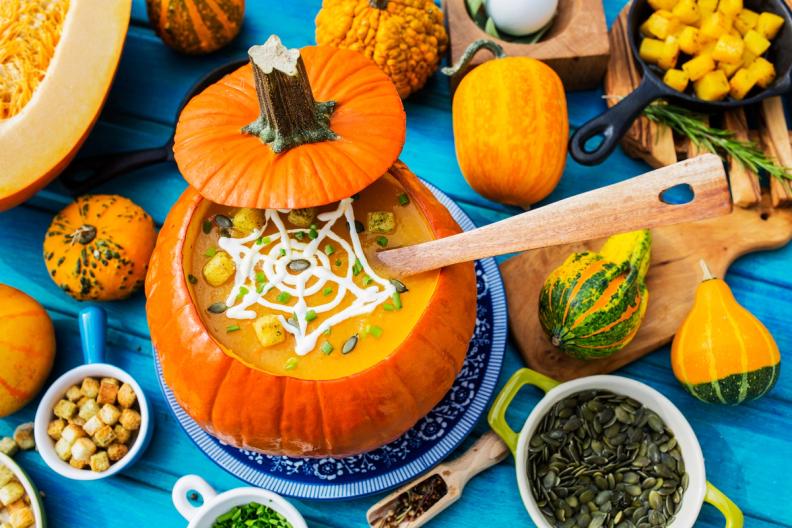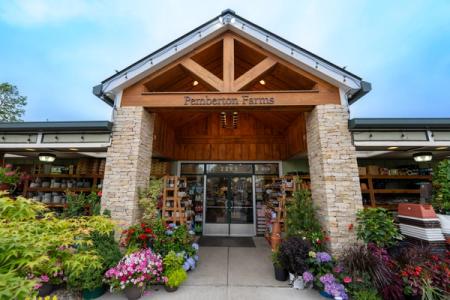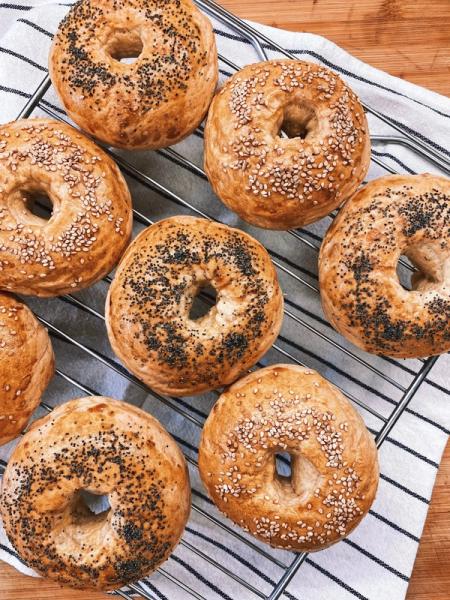Too Good To Go Blog
Make Halloween Sustainable: Less Waste, More Treats, More Fun
Too Good To Go Blog
Make Halloween Sustainable: Less Waste, More Treats, More Fun

6 Easy Swaps for a More Sustainable Halloween
Making Halloween sustainability fun, simple, and impactful
Halloween is a time for imagination. We dress up, decorate our homes, and fill buckets with sweets. Behind the fake cobwebs and candy wrappers, there's something real we often overlook: the amount of waste the holiday leaves behind. From costumes worn once to uneaten pumpkins tossed in the trash, Halloween can be more wasteful than we think.
Here’s the good news: it doesn’t have to be. A few small choices can make Halloween more thoughtful without losing any of the fun. At Too Good To Go, we believe good food should be enjoyed, not wasted. That’s why we’re sharing simple, low-waste ways to celebrate. It’s not about doing everything. It’s something you can do.
The Spooky Side of Halloween Waste
Every Halloween season, more than one billion pounds of pumpkins are grown across the United States. While they’re an iconic symbol of the holiday, many of these pumpkins are carved into jack-o'-lanterns for Halloween displays, but after the holiday, they often end up in landfill sites rather than being eaten or composted. In landfill sites, they decompose and release methane, a potent greenhouse gas.
Costumes also contribute to waste in surprising ways. A study by Hubbub, a UK environmental charity, found that 83% of Halloween costumes are made from oil-based plastics like polyester. These materials aren’t biodegradable and can take hundreds of years to break down. Making matters worse, around 40% of these costumes are worn just once before being discarded, adding to the roughly 2,000 tonnes of plastic waste generated from Halloween costumes each year in the UK alone.
Then there’s the candy. Most individually-wrapped Halloween sweets come in packaging that cannot be recycled through standard curbside programs. This plastic waste accumulates quickly and offers little value once used.
While this might sound a bit eerie, it’s not a horror story without a hopeful ending. Small, intentional choices can help cut back the waste without cutting out the fun. Let’s look at how we can enjoy the season’s traditions with a little less throwaway and a lot more creativity.
Simple Swaps for a More Mindful Halloween
Costumes That Live On
Instead of buying a new costume every year, consider reusing or reimagining what you already have. Hosting a costume swap with neighbors, friends, or your child’s school community can be a fun and social way to trade looks while cutting down on waste. Local thrift stores often stock Halloween costumes at a fraction of the price.
You can also raid your own wardrobe and get creative. That old formal wear? Instant vampire outfit with some makeup. Oversized flannel? Lumberjack. Black dress or suit? The foundation for dozens of characters. Add a few handmade props or a dash of face paint to bring the idea to life.
According to WRAP, extending the life of clothing by just nine months can reduce its carbon, water, and waste footprints by 20 to 30%. That makes every reused costume more than just a creative choice. It’s a meaningful one.
And if you do decide to buy new, opt for quality. Costumes made from natural fibers and durable materials can be worn again, handed down, or donated. Avoid anything overloaded with glitter or synthetic elements that are difficult to recycle or reuse. A one-of-a-kind costume made with care often leaves a more lasting impression — and wasting less while dressing up is something anyone can do.
Parties With a Purpose
Halloween parties are a chance to come together and celebrate, but they also tend to generate a lot of single-use waste. This year, consider using your gathering as an opportunity to model Halloween sustainable habits in a way that’s easy, festive, and realistic.
If you’re hosting, use real plates, cups, and utensils instead of disposables. It may require a little extra cleanup, but it significantly reduces waste. Cloth napkins are a sturdy, reusable alternative to paper ones, and you can even ask guests to bring containers to take home leftovers. It’s a small shift that can turn your party into a food-saving moment.
These tweaks don’t require perfection. They’re just small, intentional choices that help set a tone. Most people want to do better; they often just need a host to show how easy it can be.
Sweet Swaps & Treat Tips
Halloween and candy go hand in hand. But enjoying sweets doesn’t have to mean generating unnecessary waste. Mindful treat choices can make a difference.
Look for candy brands that use recyclable or compostable packaging. Many smaller or mission-driven companies are starting to offer more sustainable options. When giving out treats, consider purchasing fewer, larger candies instead of lots of individually wrapped minis. It can reduce packaging waste and feel just as generous.
If you’re not sure what snacks to offer or simply want to avoid the overbuying trap, let Too Good To Go help. Grabbing a Surprise Bag from a local store or bakery the day before Halloween gives you an assortment of treats that might otherwise go to waste. While you won’t know exactly what’s inside, it’s a great way to discover something new and let the mystery become part of the fun.
Got leftovers? Rather than letting them linger or tossing them, consider donating unopened sweets to a local shelter or community center. Or get creative in the kitchen; leftover candy can be turned into cookies, brownies, or snack bars. Halloween can be sweet without being wasteful.
Decor That Doesn’t Haunt the Planet
Plastic tombstones, synthetic cobwebs, and inflatable lawn monsters are eye-catching and festive. For many, they're part of what makes Halloween feel special. While some of these decorations are made from plastics that aren't easily recyclable, they can still be enjoyed for many years if stored and cared for properly. If you already have inflatables or other seasonal favorites, great! Use and love them. The more seasons you get out of each item, the better. If you're shopping for new decor, it’s worth considering items that are durable and can be reused again and again. The goal isn’t to skip the fun, but to reduce how much ends up in the trash each year.
There’s also another way to set the scene for spooky fun! Nature itself is full of seasonal beauty: think colorful autumn leaves, gnarled twigs, small pumpkins and gourds, even apples or branches. These natural materials are fully compostable and bring a rustic charm to any display.
If you’re looking for something reusable, consider investing in timeless, durable decorations you can bring out year after year. This not only saves money over time, but it reduces the demand for single-use items. Better still, turn decoration into a creative family activity. Old newspapers can become creepy cutout banners, cardboard boxes can transform into a haunted house facade, and glass jars make great ghost lanterns with a little paint.
The aim isn’t to strip Halloween of its flair. It’s about rethinking how we create that festive atmosphere. With a little creativity, it’s possible to keep things spooky without the specter of unnecessary waste.
Pumpkins With Purpose
Pumpkins are a beloved part of Halloween, but they’re often treated as decor first and food second, if at all. A carved pumpkin usually lasts about five days on a porch before it starts to slump and mold. From there, it tends to be thrown out, even though most of it is still perfectly usable.
Instead of letting your pumpkin go to waste, consider all the ways it can still shine. The seeds inside are not only edible but nutritious. According to the USDA, pumpkin seeds are packed with protein, healthy fats, magnesium, zinc, and iron. Roasting them with a bit of oil and seasoning makes for a delicious snack.
If you haven’t carved your pumpkin yet, scoop out the flesh and use it for soups, muffins, pies, or even savory dishes like curry. One cup of cooked pumpkin provides 245% of your daily vitamin A needs .
Consider choosing pie pumpkins (also known as sugar pumpkins) when shopping. They’re smaller, sweeter, and more flavorful than the large carving varieties, which are technically edible but often tasteless.
To reduce food waste and get the most out of your pumpkin:
Roasted Pumpkin Seeds
After scooping them out, rinse and pat dry. Toss with a little oil and salt, then roast at 350°F for 15–20 minutes, stirring once or twice, until golden and crisp. For extra flavor, try cinnamon sugar or a dash of chili powder. It’s a simple way to turn scraps into snacks—and avoid another plastic-wrapped option.
Pumpkin Muffins
Start with a pie pumpkin. Cut in half, scoop out the seeds (set those aside to roast), and place cut-side down on a baking sheet. Roast at 400°F for about 35–40 minutes or until the flesh is soft when pierced with a fork. Let cool slightly, then scoop out the flesh and purée in a blender or food processor until smooth.
Preheat your oven to 350°F and line a muffin tin. In one bowl, whisk together 1½ cups all-purpose flour, 1 tsp baking soda, ½ tsp salt, 1 tsp cinnamon, and ½ tsp nutmeg. In another bowl, mix 1 cup of your pumpkin purée, 2 eggs, ½ cup brown sugar, ⅓ cup vegetable oil, and 1 tsp vanilla extract. Stir the wet and dry ingredients together until just combined. Divide the batter into muffin cups and bake for 20–22 minutes. Let cool and enjoy, or store extras in the fridge or freezer to reduce food waste later in the week.
Once a pumpkin has been carved and displayed, it’s usually no longer suitable for eating, but it’s still not trash. Composting is your best bet. Some communities offer post-Halloween pumpkin collection events, or you can break it into pieces and add it to your home compost bin. Certain local farms and zoos even accept old pumpkins for animal feed. Alternatively, you can leave your carved pumpkin in a wooded area or garden (free of candles or decorations), where wildlife might enjoy a seasonal snack.
When food like pumpkins ends up in a landfill, it decomposes without oxygen and produces methane. According to the EPA, this greenhouse gas is about 28 to 30 times more potent than carbon dioxide over a 100-year period.. With just a bit of planning, your jack-o’-lantern can live on well past Halloween night, without ending up as landfill gas.
Trick-or-Treat Without the Trash
Trick-or-treating is the heart of Halloween night for many families, and it often kicks off with a trusty treat container in hand. Some kids use the same pumpkin bucket or canvas tote for years, and sometimes even pass them down to siblings. That kind of longevity is something to celebrate. On the other hand, the flimsier, mass-produced bags that flood store shelves each season aren’t built to last. They tend to tear or fall apart, which makes them more likely to end up in the trash after just a few uses.
Luckily, there are easy ways to swap out single-use containers for better alternatives. A pillowcase is a classic go-to: it’s durable, spacious, and already in your home. Reusable tote bags or sturdy buckets also do the job well and can double as shopping bags or storage afterward. For a fun pre-Halloween activity, invite kids to decorate their own trick-or-treat bag using fabric paint, markers, or patches. It turns a simple object into a keepsake, and it’s a lot more memorable than a plastic pumpkin bucket.
These small changes don’t just reduce waste, they help kids (and adults) build habits that carry forward into the rest of the year.
Don’t Let the Good Stuff Go to Waste
Halloween may only last a night, but the choices we make around it can ripple long after the decorations come down. Whether it’s buying just the candy you’ll actually give out or composting your carved pumpkins, the small, thoughtful moves matter.
If you want to take it one step further, Too Good To Go is a great way to keep cutting back on food waste. The app connects you with local businesses that have extra food. It’s perfect if you’re looking for a last-minute party snack or just want to rescue something delicious from going uneaten. It’s not about choosing the perfect item (you won’t know what you’re getting), but about staying flexible and making use of what’s already there.
You don’t need to overhaul your holiday. Just bring a little intention to it.
This Halloween, enjoy what you love about the holiday and try to waste a little less along the way. It’s simple. It’s doable. It’s something you can do.
Frequently Asked Questions
What is Halloween sustainability?
Halloween sustainability refers to making eco-conscious choices during the Halloween season—like reducing waste from costumes, candy wrappers, and decorations—so the holiday is less harmful to the environment.
How can I make my Halloween costume more sustainable?
Reuse costumes from previous years, host a costume swap, shop secondhand, or create DIY outfits from clothes you already own. Avoid costumes made from plastic-heavy materials like polyester when possible.
Are there eco-friendly ways to decorate for Halloween?
Yes! Use natural items like pumpkins, autumn leaves, and branches, or repurpose materials you already have at home. If you buy new decor, choose reusable items you’ll keep for many years.
What should I do with leftover Halloween candy?
Unopened candy can be donated to shelters or food banks. You can also repurpose leftovers in baking projects like cookies or snack bars to prevent waste.
What’s the best alternative to plastic trick-or-treat bags?
Opt for reusable options like pillowcases, canvas totes, or small buckets that can be decorated and reused every year.
How can Too Good To Go help me reduce waste around Halloween?
Too Good To Go connects you with local shops, bakeries, and restaurants offering Surprise Bags filled with food that would otherwise go to waste. It’s a great way to grab last-minute party treats or snacks while supporting Halloween sustainability.
Share this



